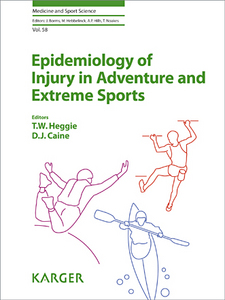The epidemiology of injury in canoeing, kayaking and rafting
Franklin, Richard C., and Leggat, Peter A. (2012) The epidemiology of injury in canoeing, kayaking and rafting. In: Heggie, T.W, and Caine, D.J, (eds.) Epidemiology of Injury in Adventure and Extreme Sports. Medicine and Sport Science, 58 . Karger, Switzerland, pp. 98-111.
![[img]](https://researchonline.jcu.edu.au/25869/2.hassmallThumbnailVersion/25869_Leggat_2012_cover.jpg)
|
Image (JPEG) (Book Cover)
- Cover Image
Download (122kB) |
|
|
PDF (Published Version)
- Published Version
Restricted to Repository staff only |
Abstract
The aquatic environment is a complex mix of waterways with varying uses and hazards. It is the intersection of the use of the water and the hazards which provides enjoyment to those who use them as well as risk to a person’s health. Canoeing, kayaking and rafting have and continue to be popular recreation sports in aquatic environments. This chapter explores participation in, risks associated with and prevention strategies for keeping canoeists, kayakers and rafters safe and healthy. There is a dearth of good quality descriptive studies exploring these issues, particularly around the risks involved and the effectiveness of proposed prevention strategies. According to Outdoor Foundation, there are 23.9 million people in the USA who undertake paddling activities per annum, with canoeing (10.1 million) being the most popular activity followed by recreational kayaking (6.2 million). There were 141 deaths of canoeists (89) and kayakers (52) identified by the US Coast Guard in their recreational boating statistics data for 2009. The crude rate of death per 100,000 participants for canoeing ranges between 0.72 and 0.92 and for kayaking between 0.37 and 0.41 per annum. Although death is the most severe consequence of a misadventure while paddling, there are a range of other hazards faced such as hitting objects, waterborne diseases, hypothermia from unintended submersion, blisters, muscle strain, cuts and abrasions. There are a range of prevention strategies which have been proposed and provided in this chapter. However, there is very little evidence of their effectiveness. Further research is required in understanding the risk associated with paddling activities, the effectiveness of prevention strategies and how these strategies might be delivered.
| Item ID: | 25869 |
|---|---|
| Item Type: | Book Chapter (Research - B1) |
| ISBN: | 978-3-318-02164-6 |
| ISSN: | 1662–2812 |
| Date Deposited: | 25 Mar 2013 02:30 |
| FoR Codes: | 11 MEDICAL AND HEALTH SCIENCES > 1117 Public Health and Health Services > 111799 Public Health and Health Services not elsewhere classified @ 100% |
| SEO Codes: | 92 HEALTH > 9204 Public Health (excl. Specific Population Health) > 920499 Public Health (excl. Specific Population Health) not elsewhere classified @ 100% |
| Downloads: |
Total: 1213 Last 12 Months: 2 |
| More Statistics |




